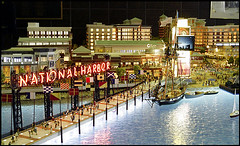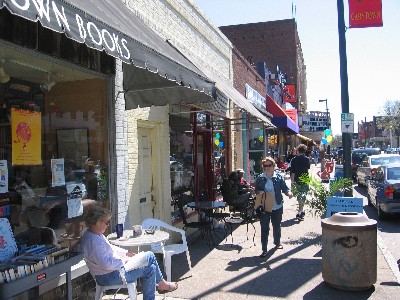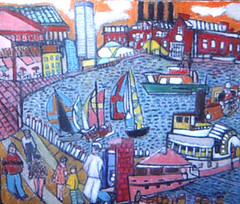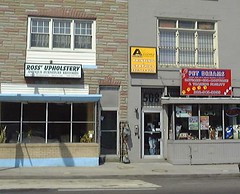Do it yourself culture #5

Comes down to Jane Jacobs and her point (one of four points for successful cities) in Death and Life of Great American Cities that cities "need a large stock of aged buildings" in order to support innovation, by having a paid off property inventory capable of charging low rents. The other aspect that she probably didn't think about directly, was having a "large stock of aged _large_ buildings." East Coast's industrial cities have these kinds of buildings. For the most part DC doesn't.
This blog entry was published as "(Why aren't people) Learning from Jane Jacobs," on July 26th, 2005. Also see, from June 2006, "(Why aren't people) Learning from Jane Jacobs revisited."
The Baltimore City Paper article mentioned below, "Tale of Two Cities," lays this all out in the first few paragraphs. It's actually far more direct on the subject than equivalent writing in the Washington Post or the Washington City Paper.
From the article:
Well, while those in the music underground face struggles in both cities, Baltimore's growing arts community highlights problems in Washington. Gentrification and attendant rising living costs have pushed Washington's creative types from formerly affordable enclaves such as the U Street corridor, Columbia Heights, and Mount Pleasant. In the past year, a number of venues have shut down or face uncertain futures, particularly the sort of alternative spaces that are integral to the Baltimore scene.
Take the Warehouse Next Door, a now defunct all-ages club attached to a theater and gallery near Washington's Chinatown, that catered to independent, local music. According to Nick Pimentel, formerly one of the club's main booking agents, the arrival of a new convention center across the street led to a gutting rise in expenses for the space, which shuttered last August. "When [the Warehouse] was around, it was very hard to break even," Pimentel says. "With property taxes quadrupling, [club owner] Paul [Ruppert] decided that it couldn't be done."
A short walk from the Warehouse Next Door is the Hosiery, another embattled warehouse where Pimentel has organized events. The Hosiery, which offers artist studios and band practice space, has long attracted small crowds for its art and live music happenings featuring underground darlings such as Devendra Banhart, !!!, and No Age. But last year attendance surged, drawing attention from the local media and, ultimately, the building's owners, who cracked down on the events.
Pimentel attributes the increased attention to the transformation of nearby Chinatown into a trendy nightlife hot spot. When the creative types moved in over a decade ago, the neighborhood was far different. "It was surrounded by transvestite hookers and crackheads," says Pimentel, who has held a studio in the building for the past eight years. "Now it's surrounded by condos." As early as next spring, the Hosiery may be condos itself, part of a retail and residential complex. "We're just waiting to get kicked out," Pimentel says of the warehouse's transformation into the chic Eye Street Lofts. "It's just a matter of time."
It's a lot easier to get kicked out when there aren't many such spaces like this to begin with, as well as the fact that one major property owner in the city has these kinds of spaces locked up, and they aren't really available for rent, at least for "fringe" uses.
Baltimore has other issues. It's 25% larger than DC. It's got more population. But because it has been losing population for so long, because the political and economic elite is still enthralled with urban renewal, because the government feels so shell-shocked they see the large stock of old buildings, especially rowhouses that are vacant, as a hindrance--that they tear buildings down at the drop of hat, and build parking structures as fast as they can...
---------------------------------

Photo: Preston Keres/The Washington Post. County unveils a $400,000 model of what the National Harbor project will look like.
Michele Dyson is a (once or twice monthly) columnist for the Washington Post, writing about Maryland issues for the back page of the Outlook section. Last Sunday's paper had the column "National Harbor: Think Small to Make It Special," about the gargantuan development coming to Prince George's County along the Potomac River. From her piece:
National Harbor is the largest private investment in the history of Maryland. In essence, it's a $2 billion wager that carries enormous risk. Much of the county's economic future is at stake, along with Peterson's reputation and money. Peterson has said that National Harbor will be his version of Las Ramblas, the grand pedestrian walkway near Barcelona's port district. But Barcelona is Spain's second-largest city. It hosted the 1992 Olympics, and its port is one of the most important in Europe. Along Las Ramblas, a visitor encounters artists, a huge opera house, fabulous food, a red-light district and an open-air pet market. Does this sound like Prince George's County? (...)
Peterson built projects all over the region, but mostly in Northern Virginia. His office park, residential and mixed-use projects have been standard suburban fare -- office buildings off major highways, apartments, condos, townhouses, single-family homes and maybe a church or two. His big-box stores, gas stations and chain restaurants have come accompanied by the inevitable giant slap of a parking lot.
Peterson has built a lot of these cookie-cutter developments, and not much distinguishes one from another. That is until recently. Peterson's work in the revitalized area of downtown Silver Spring has residents and businesses speaking in glowing terms.(**) And his National Harbor model gives reassuring evidence that the prime riverfront property just might be in the right hands. The elaborate 8-by-10-foot model generates excitement.
But if National Harbor is to become a favored destination, like San Francisco's North Beach or Miami Beach's South Beach, it will have to generate a large base of loyal local regulars. It also will need out-of towners who are willing to make a special trip there. People make special trips because they enjoy the ambience and unique qualities of an area. Toward that end, National Harbor should forgo strip mall cuisine. If we are what we eat, National Harbor will be what it serves. Forget Starbucks and ESPN Zone, and think San Francisco's Cafe Trieste and our own Vienna Inn.
Neighborhood vitality and verve can be as long-lived as New York's Greenwich Village or as newly minted as Richmond's Carytown. These places flourish because their status as celebrated destinations helps recruit artisans, artists and small businesses. These in turn plant roots, take risks and build the kinds of enterprises that further enrich the physical setting. National Harbor can do no less. Chain stores won't fill its streets, but an outstanding assortment of accomplished small businesses might.
______
** (Actually I think that the "revitalization" of Silver Spring is no different from traditional urban renewal. It's not pedestrian friendly, and small businesses are losing out, so much so that Montgomery County is suggesting that additional incentives be provided to small businesses to preserve them.)

Carytown photo by Steve Pinkus.
Like Ms. Dyson, I like Greenwich Village and Carytown in Richmond. In fact, Carytown is one of the more interesting commercial districts in the region--one that I've written about before. Yesterday's Richmond Times-Dispatch happened to have an interesting article on Carytown, entitled "Carytown: Where Change is Constant," about the ebb and flow of the retail businesses there.
And it included an incredibly important statistic--the average retail rent/square foot--In 1990, Carytown commercial rent was $10 a square foot. It's now about $18 to $20 a square foot.
National Harbor will be all new construction, meaning that prevailing rents will need to be a minimum of $60/sq. ft., and probably much higher (upwards of $120/sq. ft.). This makes it almost impossible to attract small businesses without serious subsidy.
One of the particularly grotesque aspects of the Inner Harbor in Baltimore is how, other than a couple local seafood restaurants like Phillips, it is now all chains--from ESPN Zone to California Pizza Kitchen. National chains, attracted by the large number of people-customers, have crowded out local businesses.
Sure the U.S.S. Constitution offers authenticity, but the Inner Harbor is for and about tourists, with little in the way of other authentic experiences.

Would that Inner Harbor really looked like this. Title: Inner Harbor Media: Oil on Canvas, 1998. Size: 25" x 30, not framed. By Sy Mohr.
The rent statistic is interesting in another way. Even in "marginal" commercial districts in DC, such as H Street or Brookland, the floor of asking prices for rent is probably greater than $20/sq. ft. And these are for commercial districts far less successful than Carytown. This is why we need to be much more purposive in developing and incubating independent businesses.
One of the four rostrums from Jane Jacob's Death and Life of Great American Cities is the need for "a large stock of old buildings." This isn't because she is a preservationist, but because old buildings have lower carrying costs, particularly debt service, and this allows for the incubation of new businesses--retail, office, and other (it's part of the Richard Florida equation supporting the development of creative businesses).
This gets back to the point I make over and over again--the rule of thumb from the Main Street Approach is that a retail business pays 4%-10% of its annual revenues in rent (restaurants can and do pay slightly more). Figure it out backwards from what businesses can reasonably generate in revenues... yet the asking price for commercial buildings, asking prices for rent, and often the property tax assessments are completely out of whack compared to the revenue stream that successful businesses are likely to be able to generate.
This is why salon shops are dominant in many of the neighborhood commercial district, because they have a customer base that returns again and again, and the average transaction is high (a woman can easily spend $50-$150 getting her hair done) in comparison to the average retail business.
I agree that many of the retail businesses in our commercial districts are marginal, but they need help both to improve to be able to sell more, and the commercial districts need to improve more as well, in order to be able to draw greater numbers of patrons.

The place next store is available for rent! 500 block of H Street. Photo by Michael Berman.
Las Ramblas is a real city built up over centuries. When you build a development all at once, you can't have the ebb and flow of innovation, because high rents are the one uniform condition of such development.

The Carytown Watermelon Festival is a big street festival involving many of the merchants on the street. It's scheduled for Sunday August 10th.
Speaking of rents, last Wednesday's New York Times had an article, "Columbus Ave. Distances Itself From Broadway," comparing Columbus Avenue to Broadway, and how "more personal unique" chains are locating on Columbus vs. the big chains (Barnes and Noble, etc.) on Broadway. The retail rents on Columbus Avenue average $180/sq. foot. That means that for a 2,000 sf. space, the store needs to generate at least $3.6 million in annual sales...
[Added 7/2008, also see the New York Times article, "Offering Big Spaces, Amsterdam Avenue Is Catching More Retailers."]
Labels: arts-based revitalization, building a local economy, commercial district revitalization, Jane Jacobs, urban design/placemaking, urban renewal, urban revitalization



0 Comments:
Post a Comment
<< Home